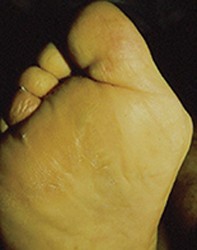Bob’s bunions
Case history
Bob is 58 years old and obese (his height is 175 cm and weight 81.4 kg, so his body mass index is 31.2 kg/m2). He has moderate bunions on his feet (Figure 1), and in the past two years these have been painful enough at times to restrict his walking program.
Apart from mild hypertension for the past eight years (controlled with an ACE inhibitor) and type 2 diabetes for the past six years (moderately controlled by trying to eat less and walk more; HbA1c 7% to 8%), Bob is generally healthy. The only other medication he takes is low dose aspirin (enteric coated 100 mg/day). Bob’s father also had bunions, for which he had surgery; one bunion resolved but the other one deteriorated.
Bob has also noticed increasing cramping of his calf muscles. He has found it more comfortable, and has self-selected, to wear a shoe with a built-up heel to reduce the cramping. He has normal foot pulses and sensation in his feet. He uses a pumice stone to remove the callus that builds up over the first metatarsal heads and has started to wear very soft shoes that don’t rub his bunions.

